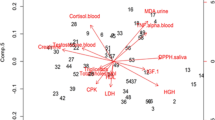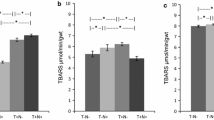Abstract
Endogenous glucocorticoids (GC) rapidly increase after acute exercise, and the phosphodiesterase’s type 5 inhibitor (PDE5i) tadalafil influences this physiological adaptation. No data exist on acute effects of both acute exercise and PDE5i administration on 11β-hydroxysteroid dehydrogenases (11β-HSDs)-related GC metabolites. We aimed to investigate the rapid effects of exercise on serum GC metabolites, with and without tadalafil administration. A double blind crossover study was performed in eleven healthy male volunteers. After the volunteers randomly received a short-term administration of placebo or tadalafil (20 mg/die for 2 days), a maximal exercise test to exhaustion on cycle ergometer was performed. Then, after a 2-week washout period, the volunteers were crossed over. Blood samples were collected before starting exercise and at 5 and 30 min of recovery (+5-Rec, +30-Rec). Serum ACTH, corticosterone (Cn), cortisol (F), cortisone (E), tetrahydrocortisol (THF), tetrahydrocortisone (THE), cortols, cortolones and respective ratios were evaluated. Pre-Ex THF was higher after tadalafil. Exercise increased ACTH, Cn, F, E, THE, cortols and cortolones after both placebo and tadalafil, and THF after placebo. The F/E ratio increased at +5-Rec and decreased at +30-Rec after placebo. Compared to placebo, after tadalafil lower ACTH, F and Cn, higher THF/F and THE/E, and not E (at +5-Rec) and F/E modifications were observed. Acute exercise rapidly influences serum GC metabolites concentrations. Tadalafil influences both GC adaptation and 11β-HSDs activity during acute exercise. Additional researches on the effects of both exercise and PDE5i on tissue-specific 11β-HSDs activity at rest and during physiological adaptation are warranted.

Similar content being viewed by others
References
E.F. Coyle, Physical activity as a metabolic stressor. Am. J. Clin. Nutr. 72, 512S–520S (2000)
D.S. Goldstein, I.J. Kopin, Adrenomedullary, adrenocortical, and sympathoneural responses to stressors: a meta-analysis. Endocr. Regul. 42, 111–119 (2008)
A.J. Scheen, O.M. Buxton, M. Jison, O. Van Reeth, R. Leproult, M. L’Hermite-Baleriaux, E. Van Cauter, Effects of exercise on neuroendocrine secretions and glucose regulation at different times of day. Am. J. Physiol. Endocrinol. Metab. 274, E1040–E1049 (1998)
A. Viru, M. Viru, Cortisol-essential adaptation hormone in exercise. Int. J. Sports Med. 25, 461–464 (2004)
S.M. Smith, W.W. Vale, The role of the hypothalamic–pituitary–adrenal axis in neuroendocrine responses to stress. Dialogues Clin. Neurosci. 8, 383–395 (2006)
M. Bouget, M. Rouveix, O. Michaux, J.M. Pequignot, E. Filaire, Relationships among training stress, mood and dehydroepiandrosterone sulphate/cortisol ratio in female cyclists. J. Sports Sci. 24, 1297–1302 (2006)
G.P. Chrousos, Stress and disorders of the stress system. Nat. Rev. Endocrinol. 5, 374–381 (2009)
S.M. Herod, A.M. Dettmer, M.A. Novak, J.S. Meyer, J.L. Cameron, Sensitivity to stress-induced reproductive dysfunction is associated with a selective but not a generalized increase in activity of the adrenal axis. Am. J. Physiol. Endocrinol. Metab. 300, E28–E36 (2011)
B.S. McEwen, Central effects of stress hormones in health and disease: understanding the protective and damaging effects of stress and stress mediators. Eur. J. Pharmacol. 583, 174–185 (2008)
Y.M. Ulrich-Lai, H.F. Figueiredo, M.M. Ostrander, D.C. Choi, W.C. Engeland, J.P. Herman, Chronic stress induces adrenal hyperplasia and hypertrophy in a subregion-specific manner. Am. J. Physiol. Endocrinol. Metab. 291, E965–E973 (2006)
L. Di Luigi, C. Rossi, P. Sgrò, V. Fierro, F. Romanelli, C. Baldari, L. Guidetti, Do non-steroidal anti-inflammatory drugs influence the steroid hormone milieu in male athletes? Int. J. Sports Med. 28, 809–814 (2007)
L. Di Luigi, C. Baldari, P. Sgrò, G.P. Emerenziani, M.C. Gallotta, S. Bianchini, F. Romanelli, F. Pigozzi, A. Lenzi, L. Guidetti, The phosphodiesterase’s type 5 inhibitor tadalafil influences salivary cortisol, testosterone and dehydroepiandrosterone sulfate response to maximal exercise in healthy man. J. Clin. Endocrinol. Metab. 93, 3510–3514 (2008)
L. Di Luigi, P. Sgrò, C. Baldari, M.C. Gallotta, G.P. Emerenziani, C. Crescioli, S. Bianchini, F. Romanelli, A. Lenzi, L. Guidetti, The phosphodiesterases type 5 inhibitor tadalafil reduces the activation of the hypothalamus–pituitary–adrenal axis in men during cycle ergometric exercise. Am. J. Physiol. Endocrinol. Metab. 302, E972–E978 (2012)
E.E. Hill, E. Zack, C. Battaglini, M. Viru, A. Viru, A.C. Hackney, Exercise and circulating cortisol levels: the intensity threshold effect. J. Endocrinol. Invest. 31, 587–591 (2008)
M.A. Minetto, F. Lanfranco, M. Baldi, A. Termine, H. Kuipers, E. Ghigo, A. Rainoldi, Corticotroph axis sensitivity after exercise: comparison between elite athletes and sedentary subjects. J. Endocrinol. Invest. 30, 215–223 (2007)
T. Bobbert, L. Brechtel, K. Mai, B. Otto, C. Maser-Gluth, A.F. Pfeiffer, J. Spranger, S. Diederich, Adaptation of the hypothalamic–pituitary hormones during intensive endurance training. Clin. Endocrinol. (Oxf) 63, 530–536 (2005)
A. Dovio, E. Roveda, C. Sciolla, A. Montaruli, A. Raffaelli, A. Saba, G. Calogiuri, S. De Francia, P. Borrione, P. Salvadori, F. Carandente, A. Angeli, Intense physical exercise increases systemic 11beta-hydroxysteroid dehydrogenase type 1 activity in healthy adult subjects. Eur. J. Appl. Physiol. 108, 681–687 (2010)
R. Gatti, E. Cappellin, B. Zecchin, G. Antonelli, P. Spinella, F. Mantero, E.F. De Palo, Urinary high performance reverse phase chromatography cortisol and cortisone analyses before and at the end of a race in elite cyclists. J. Chromatogr. B Anal. Technol. Biomed. Life Sci. 824, 51–56 (2005)
D. Muñoz, F. Toribio, R. Timón, G. Olcina, J.I. Maynar, M. Maynar, The effect of high level tennis matches on urine steroid profiles in professional tennis players. J. Sports Med. Phys. Fit. 50, 519–523 (2010)
C. Gouarné, C. Groussard, A. Gratas-Delamarche, P. Delamarche, M. Duclos, Overnight urinary cortisol and cortisone add new insights into adaptation to training. Med. Sci. Sports Exerc. 37, 1157–1167 (2005)
N. Draper, P.M. Stewart, 11β-Hydroxysteroid dehydrogenase and the pre-receptor regulation of corticosteroid hormone action. J. Endocrinol. 186, 251–271 (2005)
L. Guidetti, G.P. Emerenziani, M.C. Gallotta, F. Pigozzi, L. Di Luigi, C. Baldari, Effect of tadalafil on anaerobic performance indices in healthy athletes. Br. J. Sports Med. 42, 130–133 (2008)
A.E. Coutinho, J.E. Campbell, S. Fediuc, M.C. Riddell, Effect of voluntary exercise on peripheral tissue glucocorticoid receptor content and the expression and activity of 11beta-HSD1 in the Syrian hamster. J. Appl. Physiol. 100, 1483–1488 (2006)
Y. Koyama, K. Homma, M. Murata, H. Shibata, H. Itoh, T. Hasegawa, Free cortisol/cortisone ratio in pooled urine was increased after rapid-ACTH stimulation test under dexamethasone suppression. Endocr. J. 58, 1099–1103 (2011)
M. Vogeser, R. Zachoval, K. Jacob, Serum cortisol/cortisone ratio after Synacthen stimulation. Clin. Biochem. 34, 421–425 (2001)
M. Wamil, J.R. Seckl, Inhibition of 11beta-hydroxysteroid dehydrogenase type 1 as a promising therapeutic target. Drug Discov. Today 12, 504–520 (2007)
K. Sun, K. Yang, J.R. Challis, Differential regulation of 11 beta-hydroxysteroid dehydrogenase type 1 and 2 by nitric oxide in cultured human placental trophoblast and chorionic cell preparation. Endocrinology 138, 4912–4920 (1997)
Y. Liu, D. Mladinov, J.L. Pietrusz, K. Usa, M. Liang, Glucocorticoid response elements and 11 beta-hydroxysteroid dehydrogenases in the regulation of endothelial nitric oxide synthase expression. Cardiovasc. Res. 81, 140–147 (2009)
M.S. Cooper, P.M. Stewart, 11Beta-hydroxysteroid dehydrogenase type 1 and its role in the hypothalamus–pituitary–adrenal axis, metabolic syndrome, and inflammation. J. Clin. Endocrinol. Metab. 94, 4645–4654 (2009)
G. Valsamakis, A. Anwar, J.W. Tomlinson, C.H. Shackleton, P.G. McTernan, R. Chetty, P.J. Wood, A.K. Banerjee, G. Holder, A.H. Barnett, P.M. Stewart, S. Kumar, 11beta-hydroxysteroid dehydrogenase type 1 activity in lean and obese males with type 2 diabetes mellitus. J. Clin. Endocrinol. Metab. 89, 4755–4761 (2004)
J. Westerbacka, H. Yki-Järvinen, S. Vehkavaara, A.M. Häkkinen, R. Andrew, D.J. Wake, J.R. Seckl, B.R. Walker, Body fat distribution and cortisol metabolism in healthy men: enhanced 5beta-reductase and lower cortisol/cortisone metabolite ratios in men with fatty liver. J. Clin. Endocrinol. Metab. 88, 4924–4931 (2003)
S.A. Wudy, M.F. Hartmann, T. Remer, Sexual dimorphism in cortisol secretion starts after age 10 in healthy children: urinary cortisol metabolite excretion rates during growth. Am. J. Physiol. Endocrinol. Metab. 293, E970–E976 (2007)
T. Mostafa, Oral phosphodiesterase type 5 inhibitors: nonerectogenic beneficial uses. J. Sex. Med. 5, 2502–2518 (2008)
K.D. Hill, A.W. Eckhauser, A. Marney, N.J. Brown, Phosphodiesterase 5 inhibition improves beta-cell function in metabolic syndrome. Diabetes Care 32, 857–859 (2009)
A. Aversa, Systemic and metabolic effects of PDE5-inhibitor drugs. World J. Diabetes 15, 3–7 (2010)
P.A. Jansson, G. Murdolo, L. Sjögren, B. Nyström, M. Sjöstrand, L. Strindberg, P. Lönnroth, Tadalafil increases muscle capillary recruitment and forearm glucose uptake in women with type 2 diabetes. Diabetologia 53, 2205–2208 (2010)
X. Zhang, J. Ji, G. Yan, J. Wu, X. Sun, J. Shen, H. Jiang, H. Wang, Sildenafil promotes adipogenesis through a PKG pathway. Biochem. Biophys. Res. Commun. 396, 1054–1059 (2010)
L. De Toni, G. Strapazzon, L. Gianesello, N. Caretta, C. Pilon, A. Bruttocao, C. Foresta, Effects of type 5-phosphodiesterase inhibition on energy metabolism and mitochondrial biogenesis in human adipose tissue ex vivo. J. Endocrinol. Invest. 34, 738–741 (2011)
S. La Vignera, R.A. Condorelli, E. Vicari, R. D’Agata, A.E. Calogero, Endothelial apoptosis decrease following tadalafil administration in patients with arterial ED does not last after its discontinuation. Int. J. Impot. Res. 23, 200–205 (2011)
S. Sabatini, P. Sgrò, G. Duranti, R. Ceci, L. Di Luigi, Tadalafil alters energy metabolism in C2C12 skeletal muscle cells. Acta Biochim. Pol. 58, 237–241 (2011)
E. Giannetta, A.M. Isidori, N. Galea, I. Carbone, E. Mandosi, C.D. Vizza, F. Naro, S. Morano, F. Fedele, A. Lenzi, Chronic Inhibition of cGMP phosphodiesterase 5A improves diabetic cardiomyopathy: a randomized, controlled clinical trial using magnetic resonance imaging with myocardial tagging. Circulation 125, 2323–2333 (2012)
S. La Vignera, R. Condorelli, E. Vicari, R. D’Agata, A.E. Calogero, Circulating endothelial progenitor cells and endothelial microparticles in patients with arterial erectile dysfunction and metabolic syndrome. J. Androl. 33, 202–209 (2012)
A. Varma, A. Das, N.N. Hoke, D.E. Durrant, F.N. Salloum, R.C. Kukreja, Anti-inflammatory and cardioprotective effects of tadalafil in diabetic mice. PLoS One 7, e45243 (2012)
C. Crescioli, N. Sturli, M. Sottili, P. Bonini, A. Lenzi, L. Di Luigi, Insulin-like effect of the phosphodiesterase type 5 inhibitor tadalafil onto male human skeletal muscle cells. J. Endocrinol. Invest. 36, 1020–1026 (2013)
S. La Vignera, R.A. Condorelli, E. Vicari, F. Lotti, V. Favilla, G. Morgia, M. Maggi, A.E. Calogero, Seminal vesicles and diabetic neuropathy: ultrasound evaluation after prolonged treatment with a selective phosphodiesterase-5 inhibitor. Andrology 1, 245–250 (2013)
G. Murdolo, M. Sjöstrand, L. Strindberg, P. Lönnroth, P.A. Jansson, The selective phosphodiesterase-5 inhibitor tadalafil induces microvascular and metabolic effects in type 2 diabetic postmenopausal females. J. Clin. Endocrinol. Metab. 98, 245–254 (2013)
L. Vignozzi, M. Gacci, I. Cellai, A. Morelli, E. Maneschi, P. Comeglio, R. Santi, S. Filippi, A. Sebastianelli, G. Nesi, S. Serni, M. Carini, M. Maggi, PDE5 inhibitors blunt inflammation in human BPH: a potential mechanism of action for PDE5 inhibitors in LUTS. Prostate 73, 1391–1402 (2013)
Acknowledgments
The authors have nothing to declare. The present study was supported by a grant provided by the National Anti-Doping Commission of the Ministry of Health.
Conflict of interest
The authors declare that no conflict of interest exist.
Author information
Authors and Affiliations
Corresponding author
Rights and permissions
About this article
Cite this article
Di Luigi, L., Botrè, F., Sabatini, S. et al. Acute effects of physical exercise and phosphodiesterase’s type 5 inhibition on serum 11β-hydroxysteroid dehydrogenases related glucocorticoids metabolites: a pilot study. Endocrine 47, 952–958 (2014). https://doi.org/10.1007/s12020-014-0185-2
Received:
Accepted:
Published:
Issue Date:
DOI: https://doi.org/10.1007/s12020-014-0185-2




